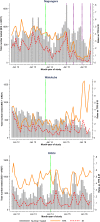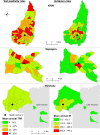Malaria Burden through Routine Reporting: Relationship between Incidence and Test Positivity Rates
- PMID: 31074412
- PMCID: PMC6609187
- DOI: 10.4269/ajtmh.18-0901
Malaria Burden through Routine Reporting: Relationship between Incidence and Test Positivity Rates
Abstract
Test positivity rate (TPR)-confirmed cases per 100 suspected cases tested, and test-confirmed malaria case rate (IR)-cases per 1,000 population, are common indicators used routinely for malaria surveillance. However, few studies have explored relationships between these indicators over time and space. We studied the relationship between these indicators in children aged < 11 years presenting with suspected malaria to the outpatient departments of level IV health centers in Nagongera, Kihihi, and Walukuba in Uganda from October 2011 to June 2016. We evaluated trends in indicators over time and space, and explored associations using multivariable regression models. Overall, 65,710 participants visited the three clinics. Pairwise comparisons of TPR and IR by month showed similar trends, particularly for TPRs < 50% and during low-transmission seasons, but by village, the relationship was complex. Village mean annual TPRs remained constant, whereas IRs drastically declined with increasing distance from the health center. Villages that were furthest away from the health centers (fourth quartile for distance) had significantly lower IRs than nearby villages (first quartile), with an incidence rate ratio of 0.40 in Nagongera (95% CI: 0.23-0.63; P = 0.001), 0.55 in Kihihi (0.40-0.75; P < 0.001), and 0.25 in Walukuba (0.12-0.51; P < 0.001). Regression analysis results emphasized a nonlinear (cubic) relationship between TPR and IR, after accounting for month, village, season, and demographic factors. Results show that the two indicators are highly relevant for monitoring malaria burden. However, interpretation differs with TPR primarily indicating demand for malaria treatment resources and IR indicating malaria risk among health facility catchment populations.
Figures







References
-
- WHO , 2016. World Malaria Report 2016. Geneva, Switzerland: World Health Organization, 38–44.
-
- WHO , 2014. World Malaria Report 2014. Geneva, Switzerland: World Health Organization, xii.
-
- WHO , 2015. Guidelines for the Treatment of Malaria, 3rd edition Geneva, Switzerland: World Health Organization.
Publication types
MeSH terms
Grants and funding
LinkOut - more resources
Full Text Sources
Medical

